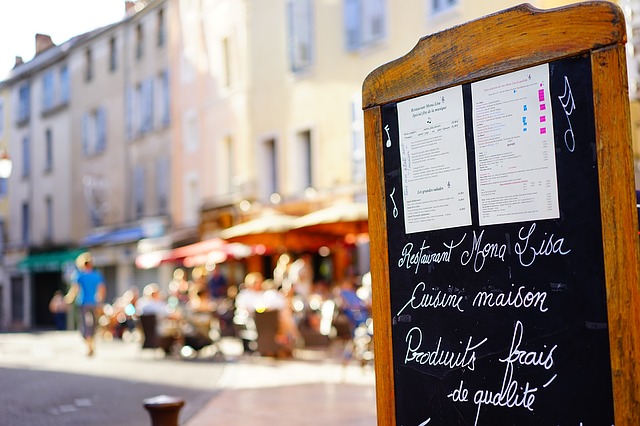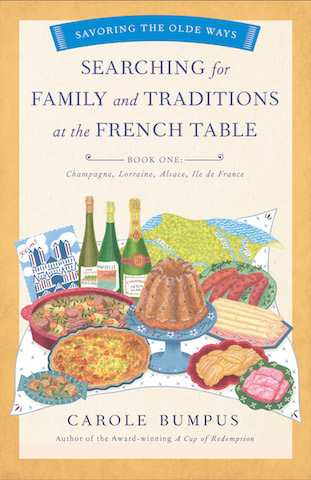The French Table: A Book Review

Warning: Do not read this book if you are hungry or within reach of a credit card. You will end up cooking (and eating) all of the included recipes, or buying a ticket for the next flight to France, or both – all while devouring this book. Because, much like the dishes and stories she describes, Carole Bumpus’ writing is simply delectable.
Searching for Family and Traditions at the French Table is the first in what promises to be an exquisite series of culinary travel memoirs. This book follows Bumpus, her husband, and her dear friend and interpreter Josiane as they travel through Champagne, Lorraine, Alsace, and Ile de France on a quest for traditional French recipes and the family histories that accompany them.

Jetting off across France, Bumpus was seeking the traditions and stories behind le cuisine pauvre (“the poor kitchen”), the peasant cooking of France, the recipes of which have been handed down through generations. Despite not speaking much French, with the help of Josiane, she was able to conduct interviews and share some profoundly amusing and touching moments with her subjects and hosts. From the correlation between Chandeleur and crêpes to “La Fête aux Escargots” (the festival of snails), there are plenty of lessons to be learned from this inaugural memoir (my personal favorite being “to begin an evening in France, you must begin with champagne”).
Bumpus details the intricacies of regional specialties and how even the same recipe can have its own variation, like a language with many dialects. She shares which wine goes best with foie gras (Sauterne, a sweet white Bordeux), and describes the delicacy of French cheeses – Gruyère, Roquefort, Reblochon… the list goes on.
Searching for Family and Traditions at the French Table is the first in what promises to be an exquisite series of culinary travel memoirs.
Having spent part of my childhood in Belgium, the memoir evoked a piece of nostalgia within my heart. Obviously, not all traditions are the same between the two nations. Yet, I was fondly reminded of the food and traditions that I lived through as a small child, such as the delights of Saint Nicholas’ Day. Even if readers have not personally experienced these traditions, Bumpus does them enough justice that they may wish to take them up – or at least try the recipes associated with them, such as the Buche de Noel (the Yule Log), bredele, or a Hammele.
Yet at the heart of all these culinary delights Bumpus shares a simple truth: “food, family, and laughter – these are the traditions that bind.”
As much as this book is about cuisine at the French table, it is much more so about family. The very idea of the trip started with family. Bumpus and Josiane planned to travel with Josiane’s mother, Marcelle, who unfortunately passed beforehand. The trip continued, in part to honor her, her French heritage, and her impact on both women’s lives.
Once in France, Bumpus explores everything from the routine Sunday night dinner to the memories of Christmas and Easter, all shared between parents, children, and grandchildren. Family is at the heart of everything in this memoir. Its joy and love blossoms not only around the dinner table of many of Bumpus’ interviewees, but throughout the pages as well. Tradition and family are intertwined.
The heart of this memoir is the honest and raw stories of the individuals who lived through the war.
Bumpus travelled to France in 2002, which is now long enough ago to make me wonder how the words and stories of this trip have fared. Some of Bumpus’ statements, particularly on the way younger generations are choosing to live, feel outdated and no longer reflective of the world we live in (for better or worse). As she spoke mostly to people her age or older, these interviews may overlook the voice of the youth.
Even so, the 17-year gap between her trip and the publication of the book beg the question, how do people celebrate now? What have younger generations continued and what have they changed? What does cuisine, tradition, and family look like in France in 2019? This memoir seems to venture to a France of another time. In fact, a reflection of an older era is one of the most moving and unexpected themes of this work.
Though searching for culinary traditions, Bumpus’ trip became a profound and intimate insight into the ways in which many French families and cities experienced World War II. The heart of this memoir is the honest and raw stories of the individuals who lived through the war. Participants spoke of how the war meant a scarcity of food and joy. They were the only years in which traditions were overlooked and celebrations foregone due to the dire circumstances in which they found themselves.
It is a touching testimony of what people witnessed and lived through, and how both French regions and families had to rebuild following the war.
For those within the Alsace and Lorraine regions, there was the added difficulty of being passed back and forth as German territory. For those individuals, their nationality was forbidden, and their traditions were an affront to the German society imposed on them – an offense that could threaten their lives. Others faced the trauma of the exodus – forced movement from their homes into other cities of France, which were not prepared to receive them.
It is a touching testimony of what people witnessed and lived through, and how both French regions and families had to rebuild following the war.
The ‘Savoring the Olde Ways’ series promises to continue with Bumpus’ travels, insights, and meals through Pas de Calais, Normandy, Brittany, Loire Valley, and the Auvergne. If this first memoir is indicative of how the series will continue, it promises to be filled with intimacy, delicacy, and delight. Until then, I will be preparing bœuf bourgignon, quiche Lorraine, and tarte flambe and am certain that once you read this book, you will be doing the same. Bon appétit!








